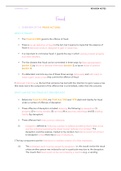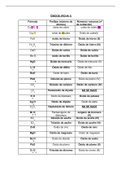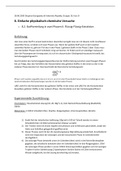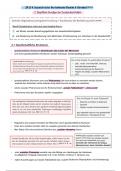CRIMINAL LAW REVISION NOTES
1. OVERVIEW OF THE FRAUD ACT 2006:
WHAT IS FRAUD?
• The Fraud Act 2006 governs the offence of fraud.
• There is no set definition of fraud in the Act, but it seems to imply that the essence of
fraud is dishonest conduct, designed to gain or cause loss.
• It is important to criminalise fraud: it guards the way in which society protects property
and other transfers.
• The Act dictates that fraud can be committed in three ways: by false representation
(section 2); by failure to disclose information (section 3); or by an abuse of position
(section 4).
• If a defendant commits any one of these three wrongs dishonestly and with intent to
make a gain/ cause a loss, they commit the offence of fraud.
! Dishonest intention, i.e. the fact that someone has lied with the intention to gain/ cause a loss
(the mens rea) is the component of the offence that is criminalised, rather than the outcome.
WHAT LAW DID THE FRAUD ACT 2006 REPLACE?
• Before the Fraud Act 2006, the Theft Acts 1968 and 1978 dealt with liability for fraud
under a number of offences of deception.
• These offences of deception included obtaining the following by deception: (1)
property, (2) a money transfer, (3) services, (4) a pecuniary advantage and (5) evading
liability (by deception).
• These offences had three common elements:
(i) Deception: defined as ‘inducing a person to believe something that is false is true
and the individual practising the deceit knows/ believes it to be false.’ The
deception could be express, implied or by conduct, but silence would not amount
to deception unless there was a duty of disclosure.
! The key component was the intentional or reckless creation of a false impression.
(ii) The prohibited result must be caused by deception: i.e. this would not be the result
unless another person was induced to act in a particular way due to the deception.
This meant that fraud could not be committed by a machine (e.g. a vending
,CRIMINAL LAW REVISION NOTES
machine) and that fraud had to be operative, i.e. believed and taken account of by
the fraudulent individual.
! For example, the victim would not have bought the car if it were not for the fraudulent
individual’s false description.
(iii) Dishonesty: the test for this was the Ghosh test.
WHY DID SUCH REFORM OCCUR?
PROBLEMATIC NATURE OF THEFT ACT:
COMPLICATED AND INACCESSIBLE:
• The scheme of liability for fraud under the Theft Acts was overly technical, detailed and
inaccessible. There were too many offences and too much overlap.
• The initial offences introduced under the Theft Act 1968 were unfit for purpose and
were rather confusing, particularly ‘obtaining a pecuniary advantage by deception.’
Although the 1978 Act solved some of these problems of application, the problems
were dealt with reactively and in a piecemeal fashion (incremental amendment) – this led
to incoherence.
⇒ Ray: sitting in a Chinese restaurant was an implied representation that the defendant had
intended to pay for the meal and by not doing so, he had conned the waiter. The court had
struggled with cases of implied representations.
⇒ Charles: the victim admitted to not being deceived.
OUTDATED:
• The Acts could not keep up with the increasingly complex world of fraud, considering
technological evolution and the rise of the internet.
• It was not possible to make a representation to a machine because the essence of the
deception offence was the tricking of the human mind. E.g. transferring funds from a
bank account through computer hacking could not amount to fraud.
⇒ Davies v Flackett: there was no deception by a machine.
! However, the Theft Act can be praised as well as criticised: it addressed forms of wrongdoing
that reflected and articulated existing social norms, which ensured there was consistent
treatment, fair warning and fair labelling.
, CRIMINAL LAW REVISION NOTES
RISKY:
• Though the offences under the Acts were precise in their terms, there was the risk that if
prosecutors charged defendants with the wrong offence, the defendants would be able
to walk away scot-free.
STRETCHING THE LAW DUE TO CAUSAL RESULT-BASED CRIME:
• The offence of ‘obtaining property by deception’ required a causal link, i.e. that the
deception caused the defendant to obtain the property.
• However, there are cases in which the victim is deceived, but they admit that they would
have handed the property over regardless. This indicates that the natural language of
the Act was being strained in order to find people guilty under the offences.
⇒ Charles: the shopkeeper stated that they would have given the goods to the defendant in
exchange for the use of the credit card, despite the defendant’s lie and lack of entitlement to
the use of that card. This is because, according to Barclay credit card transactions, the
defendant would have obtained the money from Barclay in any circumstance (as they insure
against the losses). How can the defendant have obtained the property by deception, when the
other party admitted they would have given the goods, regardless of the deception?
→ “The law was being subjected to technical assault by fraudsters.” – Attorney General
THE NEED FOR A GENERALISED OFFENCE?
• Therefore, it was questioned whether these individual cases of fraud would be better
addressed by a generalised fraud offence.
• The Law Commission’s Consultation Paper on Fraud and Deception (1999): they
rejected the broad approach on the basis that it could have been too broad and thus,
contrary to the European Convention of Human Rights. They realised the problem, but
did not think the general fraud offence was appropriate.
• However, the Law Commission Consultation Paper on Fraud (2002) later re-thought their
position and recommended the enactment of a new fraud offence that was similar to
what has now been enacted.
DID THE FRAUD ACT WORK?
• Rather than repair the Theft Acts, it was decided that it would be more efficient to start
with a clean slate. Thus, the Fraud Act is not a codifying act.
• The law needed to be short and accessible, especially so that it could be dealt with
more simply by judges; fraud had to be understood in a non-legal, non-technical sense.
1. OVERVIEW OF THE FRAUD ACT 2006:
WHAT IS FRAUD?
• The Fraud Act 2006 governs the offence of fraud.
• There is no set definition of fraud in the Act, but it seems to imply that the essence of
fraud is dishonest conduct, designed to gain or cause loss.
• It is important to criminalise fraud: it guards the way in which society protects property
and other transfers.
• The Act dictates that fraud can be committed in three ways: by false representation
(section 2); by failure to disclose information (section 3); or by an abuse of position
(section 4).
• If a defendant commits any one of these three wrongs dishonestly and with intent to
make a gain/ cause a loss, they commit the offence of fraud.
! Dishonest intention, i.e. the fact that someone has lied with the intention to gain/ cause a loss
(the mens rea) is the component of the offence that is criminalised, rather than the outcome.
WHAT LAW DID THE FRAUD ACT 2006 REPLACE?
• Before the Fraud Act 2006, the Theft Acts 1968 and 1978 dealt with liability for fraud
under a number of offences of deception.
• These offences of deception included obtaining the following by deception: (1)
property, (2) a money transfer, (3) services, (4) a pecuniary advantage and (5) evading
liability (by deception).
• These offences had three common elements:
(i) Deception: defined as ‘inducing a person to believe something that is false is true
and the individual practising the deceit knows/ believes it to be false.’ The
deception could be express, implied or by conduct, but silence would not amount
to deception unless there was a duty of disclosure.
! The key component was the intentional or reckless creation of a false impression.
(ii) The prohibited result must be caused by deception: i.e. this would not be the result
unless another person was induced to act in a particular way due to the deception.
This meant that fraud could not be committed by a machine (e.g. a vending
,CRIMINAL LAW REVISION NOTES
machine) and that fraud had to be operative, i.e. believed and taken account of by
the fraudulent individual.
! For example, the victim would not have bought the car if it were not for the fraudulent
individual’s false description.
(iii) Dishonesty: the test for this was the Ghosh test.
WHY DID SUCH REFORM OCCUR?
PROBLEMATIC NATURE OF THEFT ACT:
COMPLICATED AND INACCESSIBLE:
• The scheme of liability for fraud under the Theft Acts was overly technical, detailed and
inaccessible. There were too many offences and too much overlap.
• The initial offences introduced under the Theft Act 1968 were unfit for purpose and
were rather confusing, particularly ‘obtaining a pecuniary advantage by deception.’
Although the 1978 Act solved some of these problems of application, the problems
were dealt with reactively and in a piecemeal fashion (incremental amendment) – this led
to incoherence.
⇒ Ray: sitting in a Chinese restaurant was an implied representation that the defendant had
intended to pay for the meal and by not doing so, he had conned the waiter. The court had
struggled with cases of implied representations.
⇒ Charles: the victim admitted to not being deceived.
OUTDATED:
• The Acts could not keep up with the increasingly complex world of fraud, considering
technological evolution and the rise of the internet.
• It was not possible to make a representation to a machine because the essence of the
deception offence was the tricking of the human mind. E.g. transferring funds from a
bank account through computer hacking could not amount to fraud.
⇒ Davies v Flackett: there was no deception by a machine.
! However, the Theft Act can be praised as well as criticised: it addressed forms of wrongdoing
that reflected and articulated existing social norms, which ensured there was consistent
treatment, fair warning and fair labelling.
, CRIMINAL LAW REVISION NOTES
RISKY:
• Though the offences under the Acts were precise in their terms, there was the risk that if
prosecutors charged defendants with the wrong offence, the defendants would be able
to walk away scot-free.
STRETCHING THE LAW DUE TO CAUSAL RESULT-BASED CRIME:
• The offence of ‘obtaining property by deception’ required a causal link, i.e. that the
deception caused the defendant to obtain the property.
• However, there are cases in which the victim is deceived, but they admit that they would
have handed the property over regardless. This indicates that the natural language of
the Act was being strained in order to find people guilty under the offences.
⇒ Charles: the shopkeeper stated that they would have given the goods to the defendant in
exchange for the use of the credit card, despite the defendant’s lie and lack of entitlement to
the use of that card. This is because, according to Barclay credit card transactions, the
defendant would have obtained the money from Barclay in any circumstance (as they insure
against the losses). How can the defendant have obtained the property by deception, when the
other party admitted they would have given the goods, regardless of the deception?
→ “The law was being subjected to technical assault by fraudsters.” – Attorney General
THE NEED FOR A GENERALISED OFFENCE?
• Therefore, it was questioned whether these individual cases of fraud would be better
addressed by a generalised fraud offence.
• The Law Commission’s Consultation Paper on Fraud and Deception (1999): they
rejected the broad approach on the basis that it could have been too broad and thus,
contrary to the European Convention of Human Rights. They realised the problem, but
did not think the general fraud offence was appropriate.
• However, the Law Commission Consultation Paper on Fraud (2002) later re-thought their
position and recommended the enactment of a new fraud offence that was similar to
what has now been enacted.
DID THE FRAUD ACT WORK?
• Rather than repair the Theft Acts, it was decided that it would be more efficient to start
with a clean slate. Thus, the Fraud Act is not a codifying act.
• The law needed to be short and accessible, especially so that it could be dealt with
more simply by judges; fraud had to be understood in a non-legal, non-technical sense.











